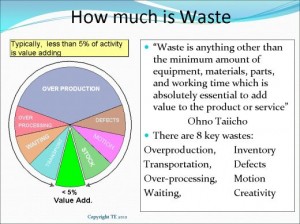
Eliminating the “Fix-it Factory”
 Many studies show that all organizations operate with from 25-50% of their activity dedicated to fixing mistakes created by other parts of the organization. This is what is called the “Fix-it Factory” in Lean literature and it represents a total waste of time and money.
Many studies show that all organizations operate with from 25-50% of their activity dedicated to fixing mistakes created by other parts of the organization. This is what is called the “Fix-it Factory” in Lean literature and it represents a total waste of time and money.
Health care is no different and many non-safety critical processes run at the high end of this range. It is discouraging to see so many providers struggling to survive as reimbursements stay flat or decline, yet doing nothing to eliminate this drain on their productivity and readily available source of new money.
The good news is, within this waste lies tremendous potential for revenue recapture and the creation of added value for patients. That means they are more likely to remain happy customers and not flee to the hospital down the road or in the big city (there is always a facility down the road in that greener grass… http://www.dailyyonder.com/40-rural-patients-stay-city-hospitals/2014/07/30/7474).
When mistakes are minimized, personnel can spend more time doing the things patients care about. Eliminating errors in a department can mean that fewer staff are needed and these extra FTEs can be redeployed to other functions that enhance patients perception of value such as care coordination, navigation, or simply doing work sooner to set them on their way more quickly. By adding to customer value, rather than thinking of these reduced FTEs as a source of cost cutting, you will be placing your facility on far stronger footing for the future.
How to Begin
Lean Six Sigma is often the perfect methodology to predictably eliminate this nagging revenue drain and transform pure waste into added patient value. Using Lean Fishbones, Value Stream Mapping, and Swimlane Diagrams, the sources of waste and error can be isolated more easily and your processes refined to enhance their value add. Using Six Sigma redesign, processes can be improved to eliminate major sources of variation and trap errors before they spread. And by focusing your improvement efforts squarely on those issues patients care about, you can become a Lean organization at the same time you create exactly the kind of environment you would frequent for your own care.

Comments are closed